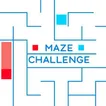




















































Discover the World of Maze Games: A Comprehensive Guide
Maze games have long fascinated players with their intricate pathways and the thrill of discovery. These games, which challenge us to find our way through complex networks, have evolved significantly since their inception. Initially simple in design, maze games have grown into elaborate experiences that engage our senses and test our cognitive abilities.
The allure of maze games lies in their ability to blend the simplicity of the concept with the complexity of execution. As players navigate through the twists and turns, they embark on a journey that is both mentally stimulating and entertaining. The evolution of this genre has been marked by the integration of new technologies, which have transformed the way we interact with these labyrinths. From the basic two-dimensional puzzles of the past to the immersive three-dimensional worlds of today, maze games continue to captivate a diverse audience.
Playing maze games is not just about entertainment; it’s a mental workout that offers cognitive benefits. These games sharpen our spatial awareness, enhance our problem-solving skills, and improve our ability to think critically. The challenges presented in maze games often require a delicate balance between being accessible enough for new players to enjoy and complex enough to keep seasoned gamers engaged.
Innovations in gameplay have kept the genre fresh and exciting. Developers have experimented with various elements to create unique experiences, from adding time constraints that raise the stakes to incorporating narrative elements that deepen the engagement. As a result, maze games have maintained their popularity, continually drawing in players who are eager to test their wits against these digital puzzles.
As the world of maze games continues to expand, it’s clear that their appeal lies in the timeless joy of exploration and the satisfaction of overcoming challenges. This comprehensive guide will delve deeper into the captivating world of maze games, exploring their history, cognitive benefits, gameplay innovations, and the importance of accessibility and inclusivity in game design.
Maze Games: An Intriguing History and Evolution
The origins of maze games can be traced back to the earliest days of computing, where they served as a fundamental challenge for both programmers and players. These digital labyrinths were initially rendered in stark, two-dimensional spaces, where the objective was straightforward: navigate from point A to point B without getting lost. As technology advanced, so did the complexity and visual appeal of these puzzles, transforming them into more than just a test of direction.
The evolution of maze games is a testament to the human fascination with exploration and the joy of solving puzzles. With the advent of more powerful computers and gaming consoles, developers began to craft mazes that were not only challenging but also visually stunning and thematically rich. The simple act of finding one’s way out was augmented with storylines, characters, and objectives that went beyond the maze itself.
The integration of new technologies, such as virtual reality and augmented reality, has further revolutionized the genre. These innovations have allowed for the creation of immersive experiences that blur the line between the player’s reality and the game world. Players can now step directly into the maze, experiencing a sense of presence and immersion that was previously unimaginable.
Despite the leaps in technology and complexity, the core appeal of maze games remains unchanged. The satisfaction derived from successfully navigating through a maze taps into a primal instinct—a mix of curiosity, problem-solving, and the triumph of overcoming obstacles. As we continue to push the boundaries of what maze games can be, their ability to captivate players for generations stands as a testament to their enduring charm.
Mazes and Puzzles: The Cognitive Benefits of Playing
Maze games are more than just a source of entertainment; they are a mental gymnasium where players can exercise and enhance various cognitive skills. Engaging with these puzzles stimulates the brain, improving spatial awareness as players learn to navigate and visualize the complex layouts of mazes. This heightened spatial cognition is crucial not only in gaming but also in everyday tasks such as map reading and spatial navigation.
Problem-solving is another significant cognitive benefit of playing maze games. Players are often presented with intricate puzzles that require logical thinking and strategy formulation. This continuous engagement with problem-solving tasks sharpens the mind, fostering an analytical mindset that can be applied to real-world situations.
Moreover, maze games can improve concentration and focus. The need to remember paths and avoid dead ends demands attention to detail and the ability to maintain focus over extended periods. This can have positive effects on players’ ability to concentrate in other areas of life, such as work or study.
The cognitive challenge of maze games is carefully balanced to be accessible to newcomers while still providing a challenge to seasoned players. This balance ensures that the games remain approachable for a wide audience, allowing everyone to reap the cognitive benefits regardless of their experience level.
In essence, maze games serve as a fun and engaging way to exercise the brain. By offering a variety of challenges that require mental agility and strategic planning, these games not only provide entertainment but also contribute to the development and maintenance of important cognitive abilities.
Gameplay Innovations in Maze Games
Maze games have continually pushed the boundaries of innovation, introducing gameplay mechanics that redefine the player’s experience. These innovations keep the genre fresh and engaging, ensuring that each game offers a new twist on the classic formula of navigating through a labyrinth.
One of the most significant gameplay advancements has been the introduction of time trials. These timed challenges add a layer of pressure that tests not only the player’s problem-solving skills but also their ability to remain calm under stress. The ticking clock creates a sense of urgency, making every decision and every turn critical to success.
Another innovative aspect is the incorporation of horror elements into maze games. The natural tension of finding one’s way through an unknown and potentially dangerous environment is amplified with eerie atmospheres and jump scares. This blend of psychological thrill with the traditional maze structure offers a more emotionally charged experience, appealing to those who seek an adrenaline rush.
The creation of immersive 3D environments has also been a game-changer. By allowing players to explore mazes in a three-dimensional space, these games offer a more realistic and engaging experience. The depth and realism provided by 3D graphics make the act of navigating through the maze more intuitive and visually captivating.
These gameplay innovations not only add variety but also increase the replay value of maze games. Each new mechanic requires players to adapt their strategies and approach, ensuring that the experience remains challenging and enjoyable. As developers continue to experiment and introduce new elements, the maze game genre remains at the forefront of creative and interactive gameplay design, captivating players with its ever-evolving challenges.
Ensuring Accessibility and Inclusivity in Maze Game Design
Maze games, like all forms of entertainment, should be designed with accessibility and inclusivity at the forefront. This commitment to inclusivity ensures that players of all abilities can enjoy the thrill of solving a maze. Designers can achieve this by incorporating adjustable difficulty levels, which allow players to tailor the game to their own skill set and comfort level. Additionally, offering customizable controls and considering colorblind-friendly palettes can make maze games more accessible to those with physical or visual impairments.
Subtitles and clear, easy-to-read instructions are also essential, as they ensure that players who are deaf or hard of hearing can fully engage with the game. Furthermore, including options to modify the game’s speed can benefit players who require more time to process and react to the game’s challenges.
Inclusivity also extends to the representation within the game. Characters and narratives that reflect a diverse range of backgrounds can foster a sense of belonging and validation for players from underrepresented groups. By creating an environment where everyone feels welcome, maze games can become a more universally enjoyable experience.
Ultimately, the goal is to create maze games that are not only challenging and fun but also accessible to as wide an audience as possible. By thoughtfully considering the needs of all players, designers can ensure that the joys of maze gaming are shared by everyone, regardless of their individual challenges or differences. This approach not only broadens the appeal of maze games but also reflects a more inclusive gaming culture that values and respects all players.